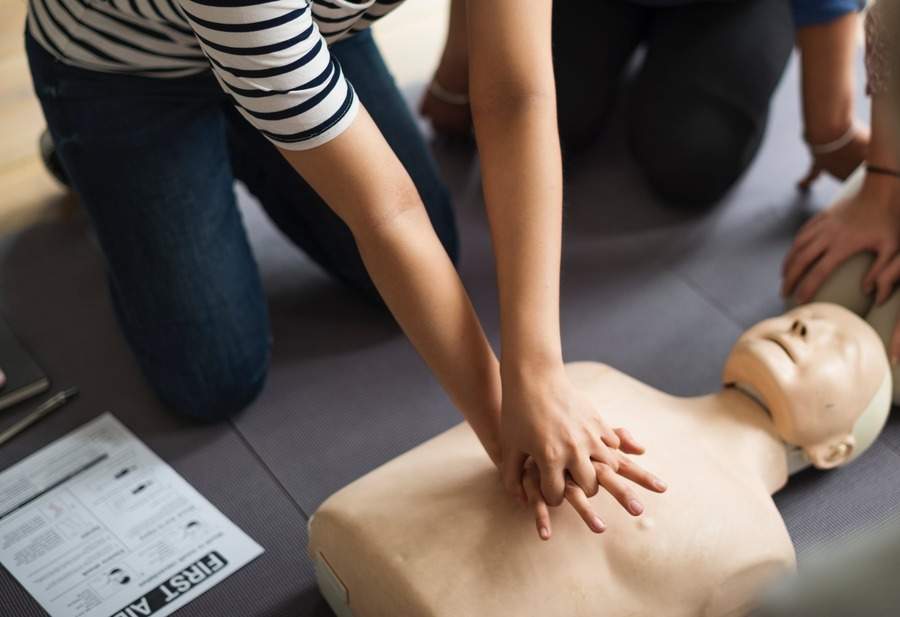Chest compressions are vital to have success during resuscitation. Majority of healthcare workers do not give effective compressions. Having a proper training on mannequins with feedback devices will help you achieve the rate and depth. Compressions and breaths should be given at a ratio of 30:2 (For every 30 compressions, provide 2 breaths). If an advanced airway (intubation) is in place, you may give compressions continuously, without stopping for breaths and breaths can be provided at every 6 seconds).
Technique of compressions

The victim should be on a flat firm surface. Place yourself next to the victim on a side. If the victim is on the floor, you should kneel down (on your knees). If the victim is on a height (stretcher / bed), you may stand. If there’s heavy clothing on the victim, remove it. Place the heel of your hand in the center of chest at the level of nipples (lower half of sternum / breast bone). Interlock your fingers as shown in picture and start pushing the chest downwards. Your wrists, elbows and shoulders should be in one plane, at 90 degrees to the floor. If you don’t maintain that 90 degree posture, you will have to use more force to achieve compression depth and that means you will get tired easily. You should not bend your elbows during compressions. If the victim is lean built, especially in case of children, using just one hand to achieve the depth is acceptable (More on pediatric BLS later).
High quality – hard and fast chest compressions have following characteristics:
- Rate 100-120 /minute
- Depth 1/3rd the chest diameter ( roughly 2 inches or 5 centimeters )
- Allow complete chest recoil
- Minimize interruptions
Maintain rate
A rate of 100-120 compressions per minute is advised. If you go at a rapid rate, heart chambers will not have time to refill with blood, rendering your CPR ineffective. If you go too slow, you might not be pumping blood adequately and organs (brain) will not be receiving enough blood. You can search for METRONOME online and use it as a guide to maintain a good rate during resuscitation. It gives a beep sound at a set rate (we advice setting a rate of 100 or 110). Please try that now, to get used to it. Click here to try.
Ensure depth
Adequate depth is needed to effectively pump the blood out of heart to mimic heart function. For an averagely built victim, a depth of at least 2 inches or 5cms is indicated. But this doesn’t work for an obese person. So look to go for a depth of 1/3rd of the chest antero-posterior diameter, which works for all individuals. While taking an exam, if a question gives options with inches, cms, and depth fraction (1/3rd), it’s wiser to choose depth fraction. If you compress too deep, there’s a chance that you might injure the internal organs.
Allow chest recoil
Chest recoil is allowing the chest to come back to it’s natural place after giving a compression. When you compress the chest, the pressure inside the chest will increase and that will stop the blood from coming back in to the chest (heart refill is inhibited). So, it is important that you allow adequate chest recoil to allow the heart to refill with blood which will be pumped out with next compression.
Minimize interruptions

A continuous compressions will lead to a sustained pressures in the blood vessels to help perfuse the brain adequately. Once the compressions are stopped, the pressures drop drastically. To regain the same pressures, you’ll have to provide a few more compressions. To maintain the perfusion reliably, we must ensure that interruptions are minimal. When providing breaths or intubation or any other procedure during CPR, take no more than 10 seconds.